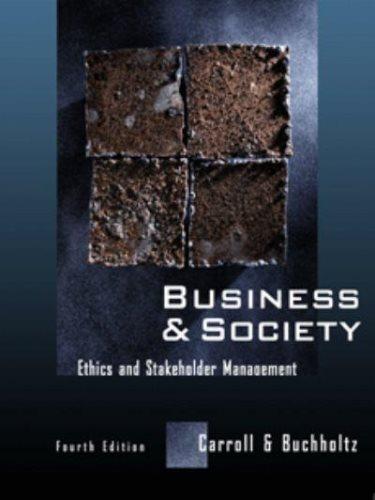What are the major issues in this case? Assess Wal- Marts corporate social responsibility using the four-part
Question:
What are the major issues in this case? Assess Wal-
Mart’s corporate social responsibility using the four-part CSR model. Is Wal-Mart socially responsible for its devastating impact on small merchants?
What responsibility, if any, does the company have to these merchants or to the communities it enters?
In his final days, the man appeared to be somewhat too frail to handle the enormous job. Yet, the courage and self-confidence that he instilled in his associates radiated a belief in low prices and good value for all to see. As his associates rode into town, that radiance put to rest the people’s fears that things had changed. Sam’s spirit, the Wal-Mart Way, had come to town.
Sam Walton, founder, owner, and mastermind of Wal-Mart, passed away on April 5, 1992, leaving behind his spirit to ride herd on the massive Wal-
Mart organization. To the consumer in the small community, his store, Wal-Mart, was seen as a friend.
On the flip side, many a small-town merchant had been the victim of Sam’s blazing merchandising tactics.
So what is Wal-Mart to the communities it services?
Is Wal-Mart the consumer’s best friend, the purveyor of the free enterprise system, the “Mother of All Discount Stores,” or, conversely, is it really “The Main Street Merchant of Doom”?
THE MAN NAMED SAM Samuel Moore Walton was born March 29, 1918, near Kingfisher, Kansas. His father was a salesman in the insurance, real estate, and mortgage businesses.
The family moved often. Sam was a strong, lean boy who learned to work hard in order to help the family.
He attended the University of Missouri starting in the fall of 1936 and graduated with a degree in business administration. During his time there, he was a member of the Beta Theta Phi fraternity, was president of the senior class, played various sports, and taught what was believed to be the largest Sunday school class in the world, numbering over 1,200 Missouri students.1 At age 22, Sam joined J. C. Penney. One of his first tasks was to memorize and practice the “Penney Idea.” Adopted in 1913, this credo exhorts the associate to serve the public; not to demand all the profit the traffic will bear; to pack the customer’s dollar full of value, quality, and satisfaction; to continue to be trained; to reward men and women in the organization through participation in what the business produces;
and to test every policy, method, and act against the question: “Does it square with what is right and just?”2 In 1962, at 44 years of age, Sam Walton opened his first Wal-Mart store. He took all the money and expertise he could gather and applied the J. C. Penney Idea to Middle America. Sam first targeted small, underserved rural towns with populations of no more than 10,000 people. The people responded, and Wal-Mart soon developed a core of loyal customers who loved the fast, friendly service coupled with consistently low prices.
Step by Step Answer:

Business And Society Ethics And Stakeholder Management
ISBN: 9780324001020
4th Edition
Authors: Archie B. Carroll, Ann K. Buchholtz





